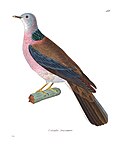Streptopelia (collared doves and turtle doves) is a genus of 15 species of birds in the pigeon and dove family Columbidae native to the Old World in Africa, Europe, and Asia. These are mainly slim, small to medium-sized species. The upperparts tend to be buffy brown and the underparts are often a shade of pinkish-brown, and they have a characteristic black-and-white patch on the neck. They have cooing or purring songs, monotonous in some, restful and soothing in others. The genus divides into two groups, the collared dove group (11 species) with uniform upperparts and a black half-collar edged with white, and the turtle dove group (4 species) with patterned upperparts and a barred side panel on the neck. They range in size from the 20–23 cm red collared dove to the 33–35 cm oriental turtle dove. Most of the species are resident or disperse over short distances, but two (the European and Oriental turtle doves) are long-distance migrants breeding in temperate areas and wintering in the tropics. The sexes are not differentiated in most of the species, except for the red collared dove, where the males are orange-red with a greyish head, and the females a duller brown.[1]

As a group, this genus is highly successful; several species are abundant in a range of habitats in the tropics, with three species having a more extensive distribution into temperate areas as well. The Eurasian collared dove (Streptopelia decaocto) in particular has expanded naturally out of its original range of the warmer temperate regions from southeastern Europe to India to colonise the rest of Europe, reaching as far west as Great Britain by 1960 and Ireland soon after, and also east across northern China to Japan. It has also been introduced into the Americas where it has now colonised most of North America, Central America, and the Caribbean, and is still spreading rapidly. Some other species have been less successful in recent years, with three species listed by IUCN as either Vulnerable or Near Threatened.[1]
Taxonomy
The genus Streptopelia was described in 1855 by the French ornithologist Charles Lucien Bonaparte.[2] The name is from the Ancient Greek στρεπτός (streptós) – literal meaning "twisted" but, by extension, "wearing a torc" (i.e., twisted metal collar) – and πέλεια (péleia) meaning "wild dove".[3] Also in 1855, the English zoologist George Robert Gray designated the type species as Streptopelia risoria, the Barbary dove.[4][5] Although Streptopelia risoria has been confirmed as a valid name by the International Commission on Zoological Nomenclature,[6] the Barbary dove is generally treated as a domesticated form of the African collared dove Streptopelia roseogrisea.[7]
Species
The genus contains 15 species:[8]
| Image | Scientific name | Common name | Distribution |
|---|---|---|---|
 |
Streptopelia turtur | European turtle dove | Europe, North Africa, western Asia; wintering Africa south of the Sahara |
 |
Streptopelia lugens | Dusky turtle dove | Tropical East Africa |
 |
Streptopelia hypopyrrha | Adamawa turtle dove | Tropical West Africa |
 |
Streptopelia orientalis | Oriental turtle dove | Asia, widespread; wintering further south in Asia |
 |
Streptopelia bitorquata | Sunda collared dove | Java east to Timor |
 |
Streptopelia dusumieri | Philippine collared dove | Philippines, endemic |
 |
Streptopelia decaocto | Eurasian collared dove | Europe, North Africa, Asia; invasive in Americas |
 |
Streptopelia xanthocycla | Burmese collared dove | Myanmar, endemic |
 |
Streptopelia roseogrisea | African collared dove | Sahel region of Africa, southwest Arabia |
| (No free license photo available) | Streptopelia reichenowi | White-winged collared dove | Southern Ethiopia, southern Somalia |
 |
Streptopelia decipiens | Mourning collared dove | Tropical Africa |
 |
Streptopelia semitorquata | Red-eyed dove | Tropical and southern Africa |
 |
Streptopelia capicola | Ring-necked dove | Eastern and southern Africa |
 |
Streptopelia vinacea | Vinaceous dove | Sahel region of Africa |
 |
Streptopelia tranquebarica | Red collared dove | Southern Asia |
| |||||||||||||||
| Phylogenetic position based on Johnson et al. (2001).[9] |
The genera Spilopelia and Nesoenas were formerly included in Streptopelia, but have since been separated out to make the genus monophyletic.[9][8]
References
- ^ a b del Hoyo, Josep (2020). All the birds of the world. Barcelona: Lynx Edicions. p. 87. ISBN 978-84-16728-37-4.
- ^ Bonaparte, Charles Lucien (1855). "Coup d'oeil sur les pigeons (quatrième partie)". Comptes Rendus Hebdomadaires des Séances de l'Académie des Sciences (in French). 40: 15–24 [17].
- ^ Jobling, James A. (2010). The Helm Dictionary of Scientific Bird Names. London: Christopher Helm. p. 367. ISBN 978-1-4081-2501-4.
- ^ Gray, George Robert (1855). Catalogue of the Genera and Subgenera of Birds Contained in the British Museum. London: British Museum. p. 150.
- ^ Peters, James Lee, ed. (1937). Check-list of Birds of the World. Vol. 3. Cambridge, Massachusetts: Harvard University Press. p. 88.
- ^ ICZN (International Commission on Zoological Nomenclature) (2008). "Opinion 2215 (Case 3380), Streptopelia risoria (Linnaeus, 1758) (Aves, Columbidae): priority maintained". Bulletin of Zoological Nomenclature. 65 (4): 327–328. doi:10.21805/bzn.v65i4.a2. S2CID 82029460.
- ^ Baptista, L.F.; Trail, P.W.; Horblit, H.M.; Boesman, P.; Garcia, E.F.J. (2020). del Hoyo, J.; Elliott, A.; Sargatal, J.; Christie, D.A.; de Juana, E. (eds.). "African Collared Dove (Streptopelia roseogrisea)". Handbook of the Birds of the World Alive. Lynx Edicions. doi:10.2173/bow.afcdov1.01. S2CID 216467812. Retrieved 16 February 2020.
- ^ a b Gill, Frank; Donsker, David; Rasmussen, Pamela, eds. (2024). "Pigeons". IOC World Bird List Version 14.1. International Ornithologists' Union. Retrieved 10 August 2024.
- ^ a b Johnson, K.P.; De Kort, S.; Dinwoodey, K.; Mateman, A.C.; Ten Cate, C.; Lessells, C.M.; Clayton, D.H. (2001). "A molecular phylogeny of the dove genera Streptopelia and Columba". Auk. 118 (4): 874–887. doi:10.1642/0004-8038(2001)118[0874:AMPOTD]2.0.CO;2. hdl:20.500.11755/a92515bb-c1c6-4c0e-ae9a-849936c41ca2.



Recent Comments